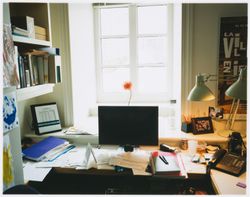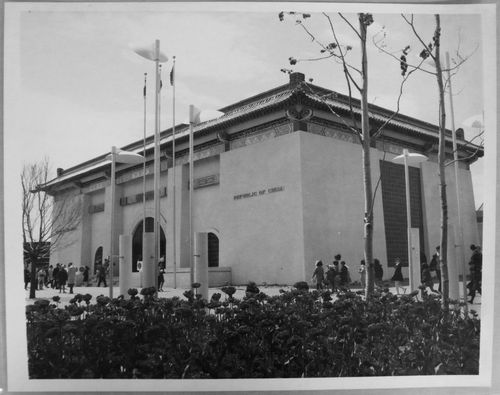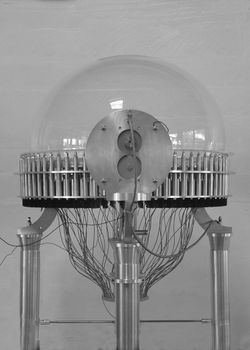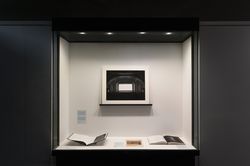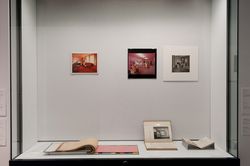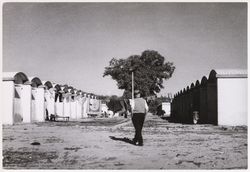Le bâtiment du Centre Canadien d’Architecture (CCA) fut conçu à la fois comme une extension de la maison Shaughnessy, une résidence construite au XIXe siècle, et comme un objet à part entière de la collection. Le CCA est inauguré en 1989 avec l’exposition Architecture et paysage qui présentait le nouvel édifice et ses jardins. En tant qu’acteur essentiel dans la recherche(...)
Vitrines
22 avril 2015 au 30 novembre 2015
Photographies du CCA, 1987-2015
Actions:
Description:
Le bâtiment du Centre Canadien d’Architecture (CCA) fut conçu à la fois comme une extension de la maison Shaughnessy, une résidence construite au XIXe siècle, et comme un objet à part entière de la collection. Le CCA est inauguré en 1989 avec l’exposition Architecture et paysage qui présentait le nouvel édifice et ses jardins. En tant qu’acteur essentiel dans la recherche(...)
Vitrines
ARCH256259
Description:
"Le Pavillon de la République de Chine à l'Expo 67 ...... Le Pavillon de la République de Chine exprime on ne peut mieux le sourire et la grâce de l'Orient. L'architecture traditionnelle du bâtiment renferme des éléments d'expositions qui veulent illustrer le rôle de ce pays sur la Terre des Hommes. / Republic of China Pavilion at Expo 67 ..... The two-stories Chinese pavilion on Ile Sainte-Hélène features the traditional architecture of that country. A display of world famous Chinese handicraft work is a special attraction."--Description.
1967
View of the Chinese Pavilion, Expo 67, Montréal, Québec
Actions:
ARCH256259
Description:
"Le Pavillon de la République de Chine à l'Expo 67 ...... Le Pavillon de la République de Chine exprime on ne peut mieux le sourire et la grâce de l'Orient. L'architecture traditionnelle du bâtiment renferme des éléments d'expositions qui veulent illustrer le rôle de ce pays sur la Terre des Hommes. / Republic of China Pavilion at Expo 67 ..... The two-stories Chinese pavilion on Ile Sainte-Hélène features the traditional architecture of that country. A display of world famous Chinese handicraft work is a special attraction."--Description.
Dissections réunit plusieurs projets sculpturaux de l’artiste Geoffrey Smedley, établi à Vancouver, et révèle les nombreuses disciplines qui articulent sa pratique : l’histoire des sciences, la géométrie, la philosophie et l’architecture. L’exposition prend la forme d’un théâtre de l’absurde mettant en scène la figure mythique du clown de Descartes, robot névrosé et(...)
Salle octogonale
6 juin 2013 au 11 août 2013
Dissections : Geoffrey Smedley
Actions:
Description:
Dissections réunit plusieurs projets sculpturaux de l’artiste Geoffrey Smedley, établi à Vancouver, et révèle les nombreuses disciplines qui articulent sa pratique : l’histoire des sciences, la géométrie, la philosophie et l’architecture. L’exposition prend la forme d’un théâtre de l’absurde mettant en scène la figure mythique du clown de Descartes, robot névrosé et(...)
Salle octogonale
La bulle constitue une merveille de tension superficielle. Dans son interprétation architecturale, elle peut être comprise comme une prouesse d’ingénierie ou comme la métaphore d’un environnement hermétiquement clos. En ce sens, la bulle apparaît, selon l’architecte Cedric Price, « quelles qu’en soient la forme ou la taille », comme un puissant symbole du futur, ou(...)
Vitrines
26 novembre 2009 au 17 janvier 2010
Sur les traces de... la bulle
Actions:
Description:
La bulle constitue une merveille de tension superficielle. Dans son interprétation architecturale, elle peut être comprise comme une prouesse d’ingénierie ou comme la métaphore d’un environnement hermétiquement clos. En ce sens, la bulle apparaît, selon l’architecte Cedric Price, « quelles qu’en soient la forme ou la taille », comme un puissant symbole du futur, ou(...)
Vitrines
Projet
Antas, Porto
CD034.S1.1974.PR03
Description:
This project series contains reproductions of drawings and photographs displayed in the exhibit to document the Antas neighbourhood, in Porto, Portugal. The exhibit text explained that: ... the SAAL Brigade intervened at the heart of an urban area which then became subject to redevelopments after the construction of the first units. The original proposal and the completed phases contrast the scale of later operations and change the perception of the original project. Nonetheless, the architectural design addressed a difficult terrain, and maintained the specificities of the urban 'ilhas' (islands) by incorporating a vernacular character, which the residents appropriated and transformed even further overtime. (The SAAL Process, Housing in Portugal 1974–76) The project architect Pedro Ramalho worked for SAAL/North with Aires Pereira, Augusto Costa, Francisco M. Lima, José Lencastre, Lídia Costa, Pedro B. Araújo, Teresa Fonseca, Vítor Bastos and the residents' association Antas, that was founded on Septermber 1st, 1975. The first phase of the project included 32 dwellings and the second, 50 dwellings. The operation began in October 1974, with a construction date in October 1975. This project series contains reproductions of design development drawings, implementation plans, axonometric views and photographic material. The original drawings and photographs were produced in 1975 and 1976 and were reproduced in 2015 for the exhibit.
1975-1976
Antas, Porto
Actions:
CD034.S1.1974.PR03
Description:
This project series contains reproductions of drawings and photographs displayed in the exhibit to document the Antas neighbourhood, in Porto, Portugal. The exhibit text explained that: ... the SAAL Brigade intervened at the heart of an urban area which then became subject to redevelopments after the construction of the first units. The original proposal and the completed phases contrast the scale of later operations and change the perception of the original project. Nonetheless, the architectural design addressed a difficult terrain, and maintained the specificities of the urban 'ilhas' (islands) by incorporating a vernacular character, which the residents appropriated and transformed even further overtime. (The SAAL Process, Housing in Portugal 1974–76) The project architect Pedro Ramalho worked for SAAL/North with Aires Pereira, Augusto Costa, Francisco M. Lima, José Lencastre, Lídia Costa, Pedro B. Araújo, Teresa Fonseca, Vítor Bastos and the residents' association Antas, that was founded on Septermber 1st, 1975. The first phase of the project included 32 dwellings and the second, 50 dwellings. The operation began in October 1974, with a construction date in October 1975. This project series contains reproductions of design development drawings, implementation plans, axonometric views and photographic material. The original drawings and photographs were produced in 1975 and 1976 and were reproduced in 2015 for the exhibit.
Project
1975-1976
Miroirs / Mirrors
Miroirs/ Mirrors prend forme à travers un dialogue indirect avec l’exposition L’histoire, par ailleurs: Go Hasegawa, Kersten Geers, David Van Severen, qui prend racine dans les références et les résonnances partagées entre les travaux de deux pratiques contemporaines mises en présence de l’histoire. Alors que L’histoire, par ailleurs se fonde sur limpression que lon a du(...)
Vitrines
22 juin 2017 au 14 janvier 2018
Miroirs / Mirrors
Actions:
Description:
Miroirs/ Mirrors prend forme à travers un dialogue indirect avec l’exposition L’histoire, par ailleurs: Go Hasegawa, Kersten Geers, David Van Severen, qui prend racine dans les références et les résonnances partagées entre les travaux de deux pratiques contemporaines mises en présence de l’histoire. Alors que L’histoire, par ailleurs se fonde sur limpression que lon a du(...)
Vitrines
Projet
Casal das Figueiras, Setubal
CD034.S1.1975.PR02
Description:
This project series contains seven reproductions of drawings displayed in the exhibit to document the Casal das Figueiras neighbourhood, in Setúbal, south of Lisbon, Portugal. The exhibit text explained that: ... the Setúbal port-city experienced the political vibrations of the revolutionary year with great intensity. The Casal das Figueiras neighbourhood was designed for a fishing community living in a difficult area to build on due to its steep incline. The challenge that the project architect Gonçalo Byrne faced was to maintain the structure of single-family housing with the outhouse or courtyard, the typology that the local populations requested, while making a large urban gesture. The proposal was based on two types of housing (the square and rectangular plans). This overcame the problem of the 36 percent slope in an architecturally striking manner, while it also managed to fulfil the major requirement inherent in any SAAL operation of minimizing costs. (The SAAL Process, Housing in Portugal 1974–76) Gonçalo Byrne worked for SAAL/Lisbon and Central South with Ana Ferreira Rebocho, Berta Sá Caetano and the residents' association Casal das Figueiras, that was founded on October 30th, 1975. The project included 420 dwellings. The operation began in July 1975 , with a construction date in October 1976. This project series contains reproductions of implementation plans and design development drawings. The original drawings were produced in 1978-1979 and were reproduced in 2015 for the exhibit.
1978-1979
Casal das Figueiras, Setubal
Actions:
CD034.S1.1975.PR02
Description:
This project series contains seven reproductions of drawings displayed in the exhibit to document the Casal das Figueiras neighbourhood, in Setúbal, south of Lisbon, Portugal. The exhibit text explained that: ... the Setúbal port-city experienced the political vibrations of the revolutionary year with great intensity. The Casal das Figueiras neighbourhood was designed for a fishing community living in a difficult area to build on due to its steep incline. The challenge that the project architect Gonçalo Byrne faced was to maintain the structure of single-family housing with the outhouse or courtyard, the typology that the local populations requested, while making a large urban gesture. The proposal was based on two types of housing (the square and rectangular plans). This overcame the problem of the 36 percent slope in an architecturally striking manner, while it also managed to fulfil the major requirement inherent in any SAAL operation of minimizing costs. (The SAAL Process, Housing in Portugal 1974–76) Gonçalo Byrne worked for SAAL/Lisbon and Central South with Ana Ferreira Rebocho, Berta Sá Caetano and the residents' association Casal das Figueiras, that was founded on October 30th, 1975. The project included 420 dwellings. The operation began in July 1975 , with a construction date in October 1976. This project series contains reproductions of implementation plans and design development drawings. The original drawings were produced in 1978-1979 and were reproduced in 2015 for the exhibit.
Project
1978-1979
Sous-série
CI001.S2.D5
Description:
Charles Rohault de Fleury was architect for the Muséum national d'histoire naturelle from 1833 to 1862. His work for the Muséum is represented in the CCA collection by a diverse group of prints and drawings. In addition to documenting his built and unbuilt projects, the inclusion of prints and drawings of museum and zoo buildings by other architects record, if only partially, the resources available to Charles in designing his buildings. This reference material provides insight into the influences on Charles' work as well as the nature of the design process itself. His built works, with the exception of the 1854 addition to the greenhouses, are illustrated in a book of prints with a brief accompanying text - "Muséum d'histoire naturelle: serres chaudes, galeries de minéralogie, etc. etc." (published 1837) (DR1974:0002:004:001; a second copy is held by the CCA library) (1). While prints are included for the Galerie de minéralogie et de géologie, the monkey house and the reservoirs, the majority of the prints are of the greenhouses (serres chaudes) begun 1833 (2). Known for their technological innovations in iron construction, these greenhouses utilized the first multi-storey load-bearing cast-iron façades for the central pavilions as well as space frame roof structures and prefabricated parts. This structural system is well documented in the prints in the CCA collection. The design was apparently inspired by the English greenhouses - a plate of which are included in the book - that Charles saw on a tour of England. The use of prestressed beams and curved roofs in the lateral wings attest to this influence. Charles' greenhouses, in turn, influenced the design of other greenhouses in Europe especially those at the Jardins Botanique in Liège and Ghent, Belgium (3). Although Joseph Paxton saw the greenhouses in 1833, it is unclear if they had an impact on the design of the Crystal Palace constructed 1850-1851 (4). The innovations of Charles' greenhouses continued to be acknowledged into the 20th century. Giedion in "Space, Time and Architecture", while erroneously attributing them to Rouhault (5)(6), refers to the greenhouses as "the prototype of all large iron-framed conservatories" (7). In addition to the greenhouses for the Muséum, the CCA collection includes three proposals (dated 1841) for a private greenhouse designed by Charles Rohault de Fleury (DR1974:0002:002:008 - DR1974:0002:002:013). The designs utilize the same curved roofs as the wings of the greenhouses at the Muséum combined with classically detailed stonework. An different aspect of Charles' work for the Muséum national d'histoire naturelle is represented in the album of unexecuted proposals -the only design drawings for the Muséum in the collection - for a Galerie de zoologie (DR1974:0002:024:001-079). Building on the typology of his earlier classical Galerie de minéralogie et de géologie (constructed 1833 -1841), the proposals, which date from between 1838 and 1862, illustrate a gradual enrichment of Charles' classical architectural vocabulary (8). They vary in their spatial configurations and façade treatments ranging from austere colonnaded designs with little ornament to more elaborate ones with richly encrusted facades, complex rooflines and more dramatic interior spaces characteristic of the Second Empire. The majority of the proposals consist of preliminary drawings illustrating the essential formal, spatial and ornamental aspects of the building. One proposal, dated January 1846, is substantially more developed than the others; in addition to general plans, sections and elevations, more detailed drawings are included for the layout of spaces, the elaboration of the facades, the configuration of the structure and even the designs for the specimen display cases. It is also worth noting that this album includes several plans outlining Rohault de Fleury's ideas for the overall development of the Muséum national d'histoire naturelle. In 1846, an album of prints of the Museo di fiscia e storia naturelle in Florence (DR1974:0002:005:001-018) was presented to Charles by the Grand Duke of Tuscany in response to his request for tracings of that building. These prints were probably used as reference material for the design of the new Galerie de zoologie described above. The portfolio of record drawings (ca. 1862) of the zoos in Antwerp, Brussels, Marseille and Amsterdam (DR1974:0002:018:001-027) is probably a dummy for a publication on zoological gardens as well as background documentation for the renovation and expansion of the zoo at the Muséum national d'histoire naturelle in Paris. Both drawings of the facilities for the animals and visitors and general plans of the zoological gardens are included. The Paris zoo project was apparently never undertaken. (1) These prints were reused in the "Oeuvre de C. Rohault de Fleury, architecte" (published 1884) (DR1974:0002:029:001-044). (2) Rohault de Fleury's greenhouses were destroyed in the Prussian bombardments of 1870. The greenhouses, which now stand in their place, are similar in layout and appearance to the original design, but their structural system is different. (3) John Hix, 'The Glass House' (Cambridge, Mass.: The MIT Press, 1981), p. 115. (4) Ibid., p. 115. (5) This error has been repeated by other authors including Henry-Russell Hitchcock, 'Architecture: Nineteenth and Twentieth Centuries' (Baltimore, Maryland: Penguin Books, 1968), p. 120. (6) Leonardo Benevolo, 'History of Modern Architecture' Volume 1: The tradition of modern architecture (Cambridge, Mass.: The M.I.T. Press, 1971), p. 22. (7) Sigfried Giedion, 'Space, Time and Architecture; the growth of a new tradition' (Cambridge: Harvard University Press, 1941), p. 181. (8) Barry Bergdoll, "Charles Rohault de Fleury: Part two: Muséum d'Histoire Naturelle and Studies on analogous Constructions in Europe", 'CCA Research Report", n.d., p. 1.
[1837-ca. 1862]
Muséum nationale d'histoire naturelle
CI001.S2.D5
Description:
Charles Rohault de Fleury was architect for the Muséum national d'histoire naturelle from 1833 to 1862. His work for the Muséum is represented in the CCA collection by a diverse group of prints and drawings. In addition to documenting his built and unbuilt projects, the inclusion of prints and drawings of museum and zoo buildings by other architects record, if only partially, the resources available to Charles in designing his buildings. This reference material provides insight into the influences on Charles' work as well as the nature of the design process itself. His built works, with the exception of the 1854 addition to the greenhouses, are illustrated in a book of prints with a brief accompanying text - "Muséum d'histoire naturelle: serres chaudes, galeries de minéralogie, etc. etc." (published 1837) (DR1974:0002:004:001; a second copy is held by the CCA library) (1). While prints are included for the Galerie de minéralogie et de géologie, the monkey house and the reservoirs, the majority of the prints are of the greenhouses (serres chaudes) begun 1833 (2). Known for their technological innovations in iron construction, these greenhouses utilized the first multi-storey load-bearing cast-iron façades for the central pavilions as well as space frame roof structures and prefabricated parts. This structural system is well documented in the prints in the CCA collection. The design was apparently inspired by the English greenhouses - a plate of which are included in the book - that Charles saw on a tour of England. The use of prestressed beams and curved roofs in the lateral wings attest to this influence. Charles' greenhouses, in turn, influenced the design of other greenhouses in Europe especially those at the Jardins Botanique in Liège and Ghent, Belgium (3). Although Joseph Paxton saw the greenhouses in 1833, it is unclear if they had an impact on the design of the Crystal Palace constructed 1850-1851 (4). The innovations of Charles' greenhouses continued to be acknowledged into the 20th century. Giedion in "Space, Time and Architecture", while erroneously attributing them to Rouhault (5)(6), refers to the greenhouses as "the prototype of all large iron-framed conservatories" (7). In addition to the greenhouses for the Muséum, the CCA collection includes three proposals (dated 1841) for a private greenhouse designed by Charles Rohault de Fleury (DR1974:0002:002:008 - DR1974:0002:002:013). The designs utilize the same curved roofs as the wings of the greenhouses at the Muséum combined with classically detailed stonework. An different aspect of Charles' work for the Muséum national d'histoire naturelle is represented in the album of unexecuted proposals -the only design drawings for the Muséum in the collection - for a Galerie de zoologie (DR1974:0002:024:001-079). Building on the typology of his earlier classical Galerie de minéralogie et de géologie (constructed 1833 -1841), the proposals, which date from between 1838 and 1862, illustrate a gradual enrichment of Charles' classical architectural vocabulary (8). They vary in their spatial configurations and façade treatments ranging from austere colonnaded designs with little ornament to more elaborate ones with richly encrusted facades, complex rooflines and more dramatic interior spaces characteristic of the Second Empire. The majority of the proposals consist of preliminary drawings illustrating the essential formal, spatial and ornamental aspects of the building. One proposal, dated January 1846, is substantially more developed than the others; in addition to general plans, sections and elevations, more detailed drawings are included for the layout of spaces, the elaboration of the facades, the configuration of the structure and even the designs for the specimen display cases. It is also worth noting that this album includes several plans outlining Rohault de Fleury's ideas for the overall development of the Muséum national d'histoire naturelle. In 1846, an album of prints of the Museo di fiscia e storia naturelle in Florence (DR1974:0002:005:001-018) was presented to Charles by the Grand Duke of Tuscany in response to his request for tracings of that building. These prints were probably used as reference material for the design of the new Galerie de zoologie described above. The portfolio of record drawings (ca. 1862) of the zoos in Antwerp, Brussels, Marseille and Amsterdam (DR1974:0002:018:001-027) is probably a dummy for a publication on zoological gardens as well as background documentation for the renovation and expansion of the zoo at the Muséum national d'histoire naturelle in Paris. Both drawings of the facilities for the animals and visitors and general plans of the zoological gardens are included. The Paris zoo project was apparently never undertaken. (1) These prints were reused in the "Oeuvre de C. Rohault de Fleury, architecte" (published 1884) (DR1974:0002:029:001-044). (2) Rohault de Fleury's greenhouses were destroyed in the Prussian bombardments of 1870. The greenhouses, which now stand in their place, are similar in layout and appearance to the original design, but their structural system is different. (3) John Hix, 'The Glass House' (Cambridge, Mass.: The MIT Press, 1981), p. 115. (4) Ibid., p. 115. (5) This error has been repeated by other authors including Henry-Russell Hitchcock, 'Architecture: Nineteenth and Twentieth Centuries' (Baltimore, Maryland: Penguin Books, 1968), p. 120. (6) Leonardo Benevolo, 'History of Modern Architecture' Volume 1: The tradition of modern architecture (Cambridge, Mass.: The M.I.T. Press, 1971), p. 22. (7) Sigfried Giedion, 'Space, Time and Architecture; the growth of a new tradition' (Cambridge: Harvard University Press, 1941), p. 181. (8) Barry Bergdoll, "Charles Rohault de Fleury: Part two: Muséum d'Histoire Naturelle and Studies on analogous Constructions in Europe", 'CCA Research Report", n.d., p. 1.
File 5
[1837-ca. 1862]
Sur les traces de... rose
Le traitement de la couleur en architecture est autant lié à ses aspects matériels qu’aux qualités sensibles qui lui sont reconnues : pouvoir évocateur, création d’une ambiance particulière, effets psychologiques distincts. Issus de la collection du CCA, des photographies, dessins, nuanciers et autres recettes chromatiques représentent, communiquent et imaginent ici la(...)
Vitrines
11 septembre 2009 au 17 janvier 2010
Sur les traces de... rose
Actions:
Description:
Le traitement de la couleur en architecture est autant lié à ses aspects matériels qu’aux qualités sensibles qui lui sont reconnues : pouvoir évocateur, création d’une ambiance particulière, effets psychologiques distincts. Issus de la collection du CCA, des photographies, dessins, nuanciers et autres recettes chromatiques représentent, communiquent et imaginent ici la(...)
Vitrines
Farhan Karim, chercheur en résidence 2016, présente ses recherches : Dans l’évolution récente de l’histoire de l’architecture, l’engagement d’architectes occidentaux auprès des nations postcoloniales émergentes a fait l’objet d’une relecture dans une perspective géopolitique plus vaste de décolonisation et de guerre froide planétaire. Une telle analyse n’est certes pas(...)
Maison Shaughnessy
7 juillet 2016, 18h
Séminaire de chercheur en résidence : Farhan Karim
Actions:
Description:
Farhan Karim, chercheur en résidence 2016, présente ses recherches : Dans l’évolution récente de l’histoire de l’architecture, l’engagement d’architectes occidentaux auprès des nations postcoloniales émergentes a fait l’objet d’une relecture dans une perspective géopolitique plus vaste de décolonisation et de guerre froide planétaire. Une telle analyse n’est certes pas(...)
Maison Shaughnessy
